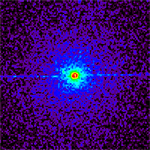April 25, 2000
CXC PR: 00-10
Using NASA's Chandra X-ray Observatory, a team of scientists has attacked one of astronomy's oldest and thorniest problems, determining the distance to a cosmic object. Through measuring the distance to an X-ray source by observing the delay and smearing out of X-ray signals traversing 30,000 light years of interstellar gas and dust, Chandra "opened a new world," said Peter Predehl of the Max-Planck Institute, Garching, Germany, the lead author on a report to be published in the European journal, Astronomy and Astrophysics.
"Geometrical distance measurements are of particular importance for astronomy. Now we have a new method that works for distant sources," Predehl said. One of the most crucial pieces of information needed in astronomy is the distance to the stars and galaxies. They are also among the most difficult to obtain because, with rare exceptions, astronomers cannot measure distance directly and must use a variety of ingenious but uncertain techniques.
This new method relies on the scattering of X-rays by interstellar dust grains between a source and the Earth. Although the scattering material is different, the dust produces a halo, much like the halo around a traffic light on a foggy night.
"When the light switches from red to green (or vice versa), the halo around the light is also slightly delayed," Predehl explained. "No one would use this delay for determining the distance to the traffic light, of course, (the delay is only a few billionths of a second). But if the 'traffic light' is 30,000 light years away, the delay is on the order 15 minutes. Using the excellent and unprecedented resolution of the Chandra observatory, we can distinguish between light which was 30,000 years on its way and other light which needed only a few minutes more. "
Other members of the team included Vadim Burwitz and Joachim Trumper, also of the Max-Planck Institute, and Frits Paerels of Columbia University, New York. Trumper and a colleague proposed using this method 27 years ago, but it could not be applied until an X-ray observatory with Chandra's unique capability was available.
The X-ray source Cygnus X-3 acts like a cosmic traffic light, or more appropriately, lighthouse. Its X-ray emission varies regularly with a 4.8 hour period, as a neutron star or black hole circles a nearby companion star. The radiation from the halo is delayed and smeared out, so the variations are damped. For the inner part of the halo, the damping is small, whereas for the outer part, the periodic variation is completely washed out. By observing the time delay and variations at different parts of the halo, the distance to the source can be determined.
Seismologists use a similar method based on the propagation of sound waves through the Earth to determine the epicenters of earthquakes or to locate unusual geological formations.
Predehl and colleagues observed Cygnus X-3 for 3.5 hours with Chandra using the Advanced CCD Imaging Spectrometer (ACIS). By analyzing the time variations in the halo, the astronomers determined that the distance to Cygnus X-3 is 30,000 light years, within about 20 percent accuracy. The accuracy was limited by the short observing time, which was less than the full 4.8 hour period of variation. The team hopes to refine this estimate in the near future as data from a longer observation of the source becomes available.
The X-ray scattering method of measuring cosmic distances depends on the fact that X-rays, because of their high energies, are scattered through small angles by dust grains. It cannot be used with optical telescopes because visible light photons have lower energy and are scattered through much larger angles by the dust grains.
In principle, the method could also work for nearby galaxies, such as the Small and Large Magellanic Clouds and the Andromeda Nebula. If so, it would help astronomers in their quest to understand the size and age of the universe, since it would provide an independent estimate of the size of the first steps on the cosmic distance ladder.
The ACIS instrument was built for NASA by the Massachusetts Institute of Technology, Cambridge, Mass., and Penn State University, University Park. NASA's Marshall Space Flight Center in Huntsville, Ala., manages the Chandra program. TRW, Inc., Redondo Beach, Calif., is the prime contractor for the spacecraft. The Smithsonian's Chandra X-ray Center controls science and flight operations from Cambridge, Mass.
For images connected to this release, and to follow Chandra's progress, visit the Chandra site at:
High resolution digital versions of the X-ray image (JPG, 300 dpi TIFF) are available at the Internet sites listed above.
MEDIA CONTACTS
Dolores Beasley
Headquarters, Washington, DC
Phone: 202/358-1753
Steve Roy
Marshall Space Flight Center, Huntsville, AL
Phone: 256-544-6535
http://www.nasa.gov/centers/marshall/news
Dr. Wallace Tucker
Chandra X-ray Observatory Center
Harvard-Smithsonian Center for Astrophysics, Cambridge, MA
Phone: 617-496-7998



